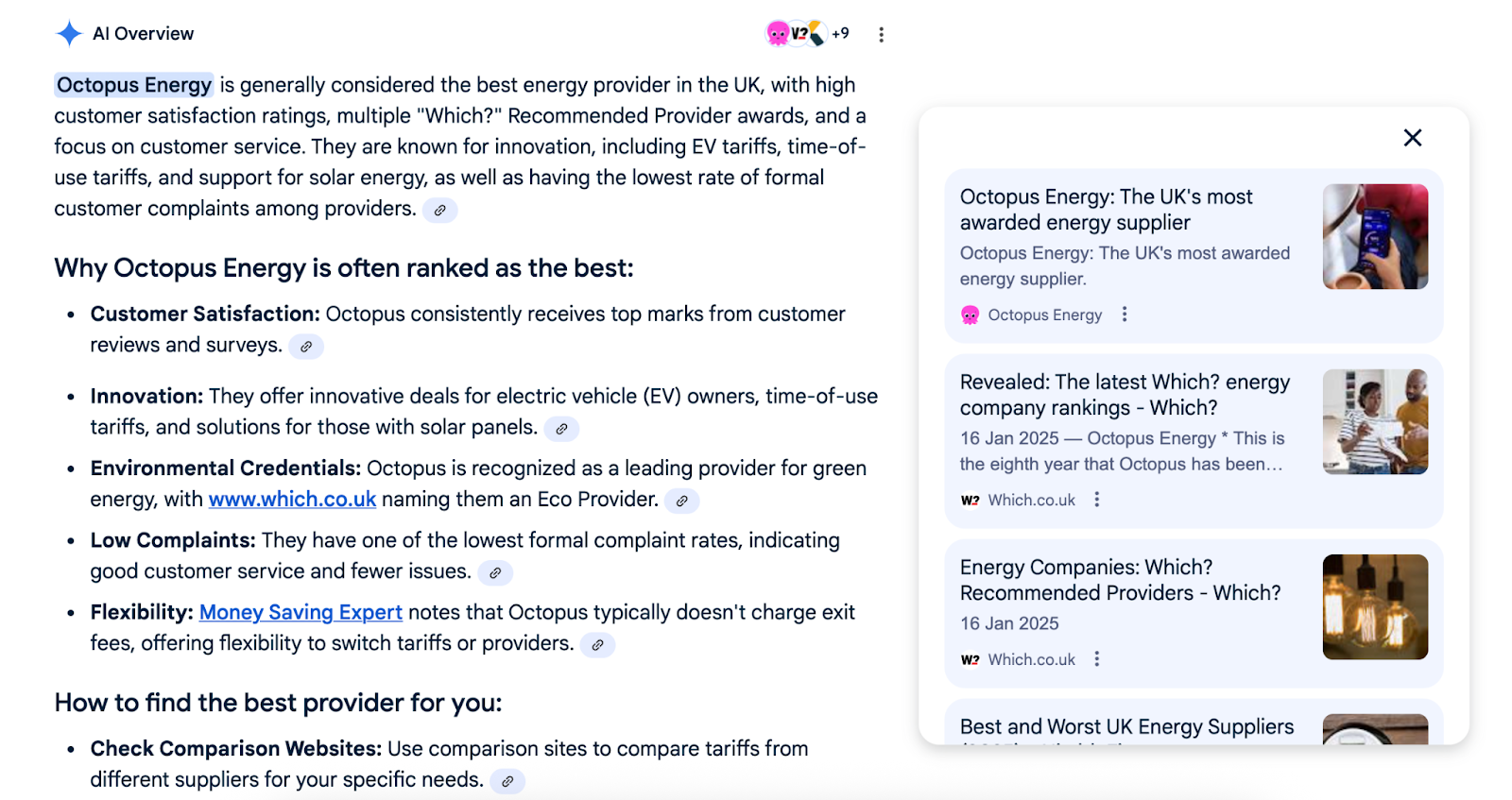
How to Stay Relevant in a World of AI Overviews & Query-Fans
Published November 17, 2025
Thank you to Laura Iancu who explains query fan out, the schema for LLMs debate, and the hallmarks of good content for humans and AI.
Remember when “ranking #1 on Google” was the holy grail? Yeah… about that…
In 2025, SEO looks more like whispering sweet nothings to AI than shouting keywords at search engines. Google’s AI Overviews (AIO), ChatGPT Search, Perplexity, and other generative search engines have officially blown up the blue-link era, and ushered in the age of experience.
So what does this mean for SEO and UX? In the first part of 2020, we had SXO (which I learned recently it’s a very naughty word in Spanish). It was fairly straightforward, SEOs were getting accustomed to UX best practices, and the other way around. Then, they’d start working together, and deliver a nice experience from SERP to finish.
But now we have some kind of monster. And no, not the underrated Metallica album, but something more metal than that. Bit of a hydra if you like, with query fans and shiny new heroes offering upgraded weaponry that pop-up every day or so to help you “win the AI game”. Some will update the skin and charge you extra branding it as new or innovative, some will actually know their shit.
And it’s a bit scary, but not that scary. Mainly because you’re no longer optimising for search or users, you’re optimising for both, simultaneously, because AI search now behaves like a moody, and slightly judgy C3PO.
So, let’s break down what’s changed, how it affects your content, and how you can make sure we’re keeping the droid working for the Rebel alliance with some good SXO.
Contents:
The death of the blue link (oh no, aaa!)
Once upon a time, search results were simple: ten blue links, one winner, and nine polite losers. Now? Search results have personalities, and this is what you get depending on how “chatty” they feel:
AI Overviews summarising your topic in cheerful robot voice
Citations scattered across multiple sources (if you’re lucky).
Visual snippets, carousels, FAQs, or conversational threads that keep users on the page.
Reddit, and more Reddit.
What does this mean?
With more shortcuts, users are getting answers faster, often without clicking anywhere. The first (and often only) contact that is made with the content lives in summaries, snippets, and structured data, not just positions.
And this is where UX and SEO finally go on their second official date. SEO will work towards serving the right content, but UX will have to work overtime to make sure you send the good signals back to both human and robot.
Enter the Query Fan, your new fave SEO thingy
We’ve all played with it, some got more wins than the others, and it’s definitely here to stay (at least until the next phase).
But what is Query Fan Out?
In a nutshell, when someone searches for “the best energy provider in the UK ” Google doesn’t just go fetch ten results anymore. It fans out that question into a dozen smaller ones to build a complete AI answer, what we call the Query Fan.
Each of those smaller queries could pull your content, if you’ve covered them clearly and semantically. In other words, the AI summary doesn’t come from a single page. It’s built like a mosaic, pieced together from multiple relevant sources.

But how does Google “select” these resources, and do you need to rank #1 for that query to be featured? Funny you should ask.
What I learned so far is that to “win” in AI search, you don’t need to rank #1 for one query, but you need to exist across the query fan.
And it goes without me saying this, but that’s not always going to be your best “looking page”, the chosen one, the Midi-chlorians over 20,000 one, the one you’ve had your UX team make a special featured image for, even bothered to write a good ALT text for it, and so on.
Here’s an example:
The page below is ranking in top 3 with traditional SEO. It’s a hearty alphabet soup of keywords, or a decent “bors” (as we say where I’m from), for “best electricity provider UK.” It’s a blog post that follows both UX and SEO best practices, and yet it is nowhere to be seen in AIO, where its nature and content would actually make a lot of sense.
Is this the competitive landscape taking over, or perhaps at a second glance, this piece really isn’t AIO-ready?

These are the questions that I’d ask myself if I were to work to get this piece into AIO:
Is this piece written and designed so an AI could grab a paragraph, understand it, and quote it without needing any backstory.
Can it stand alone so it can get cited?
Has it got a clear heading hierarchy?
Does it consider mini-intent? (Is the user looking to verify a fact, are they looking to compare a product or a service?)
What about trust signals? Is it obvious they know their stuff or do I need to get on my pogo-stick and find credibility elsewhere?
Checklist: how to optimise for the query fan without losing your mind
Map your fan: use tools like AlsoAsked, related searches, GSC with custom regex, and your choice of SEO tool to see what queries cluster around your topic. Then visualise it using a mindmap.

Cover the whole cluster: build topical clusters that answer each fan-out question, on-page or across linked posts. Think of your site as a web of relevance, not a collection of isolated pages.
Make every section self-contained: write modular content blocks that can be lifted into an AI summary:
Use descriptive subheadings.
Add short, definitive answers before diving deep.
Include a “TL;DR”
Design for micro-intents: each fan-out query has a slightly different user goal. Make it easy to jump, scan, and get quick answers with collapsible FAQs, numbered steps, mini infographics, etc.
What about markup language?
This one seems weird at first, after all, schema has been a standard in our trade as SEOs. But once you understand LLMs a bit more, it clicks: they learn from text by tokenising it and predicting what comes next, so they don’t really “need” explicit structure, therefore schema.
As Mark Williams-Cook points out, schema gets treated like any other words, so "@type": "Organization" basically gets squashed. In that narrow context, it’s almost useless.
That said, I wouldn’t say schema loses all its value. It still keeps things clear for humans and systems, and no SEO I know is optimising purely for LLMs.
Even if a model can’t “see” the structure, your schema makes sure data is accurate, discoverable, and usable in other contexts — think search engines, APIs, or RAG setups, where explicit structure really does matter.
Editor’s Note: The following clip from our recent webinar addresses this directly…
Is UX a ranking signal in the new context?
No, UX still isn’t a single ranking signal, and it never was.
Just like you can’t sprinkle “E-E-A-T dust” on a page and call it a day, you can’t slap on some UX tweaks and expect instant rankings. In reality, good UX isn’t a waterfall; it’s a river network, constantly flowing, occasionally drying up, sometimes “bloating”, but always in motion.
Your UX sends powerful experience signals to Google and LLMs alike. These systems don’t just crawl text anymore, they read your experience. They thrive on:
Clean headers and semantic HTML – so they can understand your structure.
Scannable, logical content – so they can summarise you accurately.
Author signals and E-E-A-T cues – so they can trust and cite you confidently.
Humans, meanwhile, just want something clear, fast, and pleasant to read. So if your page loads quickly, flows naturally, and actually makes sense? Congrats, you’ve just made both your users and the machines happy.
Positive UX Signals (rank-boosters)
Dwell time / engagement time: When users stick around, scroll, and interact, it tells Google they found value.
CTR: Clear titles and meta descriptions that match intent = more clicks from SERPs.
Low Bounce Rate / Pogo-Sticking: If users land on your page and instantly backtrack, that’s a bad sign.
Scroll Depth: Deep scrolling implies engaging, well-structured content.
Interaction Signals: Clicking tabs, expanding FAQs, or playing videos signals meaningful engagement.
Core Web Vitals: Fast load times, stable layouts, and smooth interactivity make users (and Google) happy.
Mobile friendliness: Responsive design and touch-friendly elements are now table stakes.
Task completion: Submitting forms, downloading guides, or navigating smoothly indicates good UX and intent satisfaction.
Negative UX Signals (rank-killers)
Slow Page Load: Even a 1-second delay can tank engagement and conversions.
Intrusive Pop-ups: Blocks reading, frustrates users, spikes bounce rates.
Confusing Navigation: If users can’t find what they came for, they’ll leave fast.
Thin or Misleading Content: Doesn’t satisfy intent, causes pogo-sticking.
Visual Clutter or Poor Readability: Walls of text, bad contrast, or chaotic layouts destroy focus.
Unclear Calls-to-Action: If users don’t know what to do next, they bounce.
Future-proof your content: think beyond Google
Search isn’t just a list anymore, it’s a conversation. AI interfaces like ChatGPT, Perplexity, Gemini, and Copilot aren’t ranking pages; they’re rephrasing, summarising, and quoting:
Write like it’s being read aloud, yes, voice assistants still matter.
Keep key points clear, factual, and bite-sized.
Make tools and data API-friendly, AI assistants will be browsing them directly.
Back to you
Remember, good SEO has been and always will be about common-sense. When you employ clarity, credibility, and design that actually helps people, you make experience worth it.
Some say AI has hit a plateau, but if you live and breathe SEO, that’s hard to swallow. The smarter play isn’t chasing today’s quick wins, it’s doing what we do best: strategising. We don’t need to outsmart AI; we just need to become its favourite source.

Sitebulb is a proud partner of Women in Tech SEO! This author is part of the WTS community. Discover all our Women in Tech SEO articles.

By day, Laura helps Octopus Energy tame SEO, AI, and UX beasts of the digital realm. By night, she builds Searchpedia, a personal project cataloguing the weird and wonderful world of search marketing. Equal parts Jedi, Noldorin elf, and Witcher, Laura believes great optimisation is part science, part storytelling, and occasionally, pure magic. They’re also an engaged member of WTS & Neurodivergents in SEO.
Articles for every stage in your SEO journey. Jump on board.
Related Articles
 Speed-to-Meaning: Technical & Measurement Blueprint for AI Search
Speed-to-Meaning: Technical & Measurement Blueprint for AI Search
 Auditing Core Web Vitals with Chrome DevTools MCP
Auditing Core Web Vitals with Chrome DevTools MCP
 Plain-text Lifelines: How to Make Medical Content Visible in AI Search
Plain-text Lifelines: How to Make Medical Content Visible in AI Search
 Sitebulb Desktop
Sitebulb Desktop
Find, fix and communicate technical issues with easy visuals, in-depth insights, & prioritized recommendations across 300+ SEO issues.
- Ideal for SEO professionals, consultants & marketing agencies.
Try our fully featured 14 day trial. No credit card required.
Try Sitebulb for free Sitebulb Cloud
Sitebulb Cloud
Get all the capability of Sitebulb Desktop, accessible via your web browser. Crawl at scale without project, crawl credit, or machine limits.
- Perfect for collaboration, remote teams & extreme scale.
If you’re using another cloud crawler, you will definitely save money with Sitebulb.
Explore Sitebulb Cloud
 Laura Iancu
Laura Iancu

